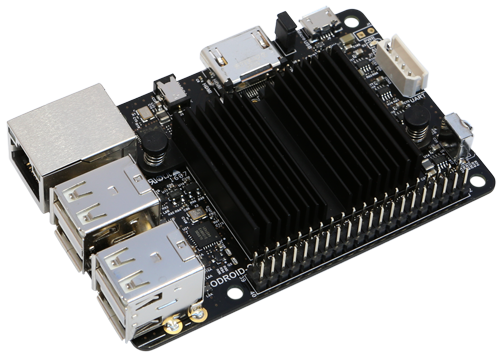Minimal Operating System for ODROID C2 Single-board Computer. Copyright (C) 2016 Federico "MrModd" Cosentino
This program is free software: you can redistribute it and/or modify it under the terms of the GNU General Public License as published by the Free Software Foundation, either version 3 of the License, or (at your option) any later version.
This program is distributed in the hope that it will be useful, but WITHOUT ANY WARRANTY; without even the implied warranty of MERCHANTABILITY or FITNESS FOR A PARTICULAR PURPOSE. See the GNU General Public License for more details.
You should have received a copy of the GNU General Public License along with this program. If not, see http://www.gnu.org/licenses/.
ODROID C2 is an affordable and powerful Single-Board computer. Its characteristics are:
- 64bit Cortex-A53 (ARMv8) quad-core processor @ 2GHz
- 2GB DDR3 Memory @ 912MHz (32bit Bus)
- Gbit Ethernet
- 4 USB 2.0 ports + 1 Micro-USB 2.0 (OTG) port
- Full Type-A HDMI with CEC support
- Infrared receiver
- Serial port
- GPIO, I2C, UART, ADC on main 40 pin header
- I2S on separate header
For a full description of the board visit the official page.
Hardkernel offers a very useful portal for all the technical documentation of this board. It's an important resource especially for hardware description and headers pinout.
Essential for this project are the technical manuals for the board. You will need to understand how to access at very low level all the devices and how memory and devices are mapped to the physical addresses. You will also need to access some ARM co-processors in order to activate some CPU functionalities such as the floating point unit.
All needed manuals are publicly available for download. Here is a list of what you'll need:
- Board schematics: useful, but not essential; it helps you understand how physical devices are connected to the SoC (such as at which GPIO the System LED is wired);
- SoC manual: it describes how to access the peripherals and how memory is mapped;
- Technical Reference Manual: the main processor manual that describes all its functional aspects (interrups, timers, cache, synchronization primitives, etc.);
- Programmer's Guide: a useful manual to those who want to write code for this CPU; it contains some details about the instruction set, the exception handling, the MMU and more;
- Architecture Reference Manual: it contains the complete instruction set of the ARM processor. This manual can be obtained with an ARM account, but it's not essential.
In addition to these it may be useful have a look at the ARM page for Cortex-A53.
This repository contains multiple branches; each of which defines a milestone for the project with an increasing complexity.
The master branch contains just the basic scripts required in order get all the essential tools:
- Cross compiler: required in order to compile bare-metal programs and bootloader for target architecture;
- Bootloader: the first external program the CPU calls, this board uses U-Boot as described on the official Wiki page;
- TFTP Server: optional, but very useful to quickly test a new version of the binary program; just compile and reboot the board, U-Boot configuration will instruct to get the file from the network. As TFTP server this project uses Dnsmasq.
Other branches add at what's already inside the repository folder the code that should be executed to the board. Subsequent project steps adds new features to all previous ones.
There are two main scripts called get_ready.sh and set_tftp.sh. First one is intended to prepare the environment for crosscompiling and for booting the board. The second one sets up a local TFTP server that delivers the binary program to the board if connected via ethernet to the machine where you are compiling.
Invoke these scripts with "-h" option for an help on the correct parameters to pass.
$ ./get_ready.sh -cupthis invocation of get_ready.sh downloads the correct toolchain, clones U-Boot repository and compiles it with the cross compiler. All needed files will be put in a folder called sdcard/. Read the README file inside it for a manual to the preparation of the MicroSD for the board.
To start the TFTP server invoke the script set_tftp.sh. By default it will set a static "10.0.0.1/24" ip to "eth0" and then it will start Dnsmasq on that interface. In order to change the ethernet interface pass the correct name as last argument of the invocation. For example:
$ ./set_tftp.sh enp0will use "enp0" instead of "eth0".
You should not change the IP address because it is also referenced by "boot.ini" file that goes on the MicroSD card. If you need to modify this static address remember to update "boot.ini" as well.
Note that this script tries to set a static IP address to the network interface before starting the server. If you encounter some issues obtaining the file with TFTP protocol check the correctness of the IP on the ethernet interface of your PC. NetworkManager, if present, could interfer with this script resetting the interface whenever the LAN connection is absent. If you have any problem you can always copy the binary file to the microSD card and then uncomment the line on "boot.ini" that enables the local boot.
Finally use set_environment.sh in order to export "CROSS_COMPILE" and other variables required by Makefile to get the right compiler. You should source this script as shown below instead of invoke it directly:
$ source ./set_environment.shThis may happen when you are on a 64bit system, but the downloaded toolchain is for 32bit. Under Ubuntu you should resolve installing the required 32bit libraries:
# apt-get install libc6-i386 lib32stdc++6 lib32gcc1 lib32ncurses5 lib32z1Or under RHEL/CentOS/Fedora:
# yum install glibc.i686 libstdc++.i686 zlib.i686On other distributions install the equivalent packages.
